Darwin, the capital city of the Northern Territory of Australia, is 3,144 kilometres away from Sydney.
Visitors to Darwin may think that the buildings look fairly new, but
just under the modern exterior lies a deep Aboriginal history, pioneering tales and landmarks, and the scars left by WWII and Cyclone Tracy.
The Larrakia Aboriginal People
The Larrakia (Gulumerrgin) Aboriginal people refer to themselves as the Saltwater People and have lived around the Darwin area (Garramilla) for thousands of years. This Aboriginal group have a close relationship with the sea and in the past traded with neighbouring groups such as the Tiwi, Wadjiginy and Djerimanga people, with whom they intermarried and share ceremonies and songlines.
A songline marks the path across the land or sky
travelled by one of the creator-beings/ancestors during the Dreaming.
The Larrakia language, also known as Gulumirrgin, is spoken by only a few people near the city of Darwin.
In 1882, Police Inspector Foeslche reported that Aboriginal "corrobories" in Northern Australia were performed on many occasions such as a death, start of hostilities, on return from
visits to neighbouring groups or "when they feel inclined to be jolly".
Thomas Parkhouse, a Darwin-based government official noted in the 1890s that Aboriginal people came and went according to various
seasonal factors, with corroborees performed for many different reasons including marriage and initiation. A Larrakia man named "Pickles" worked for Parkhouse and may have provided him with information.
The Larrakia decorated their bodies and hair with ochre, dogs’ teeth, seeds and shells. In 1873, William Wildey described the Larakia people as "most happy" and "contented." The young girls, he claimed were "very pretty, symmetrically formed and walked majestically."
 |
| Australia: an Aboriginal man (Ned Woolnah?) with a bone through his nose. Photograph by Henry King, ca. 1890. Many Aboriginal people, both men and women, wore septum piercings of wood, bone, a feather or a grass stalk, PD |
 |
Jacky, Larrakia Tribe, Port Darwin, NT. Australian Town and Country Journal (Sydney, NSW : 1870 - 1919), Saturday 24 July 1897 |
Tragically, many Aboriginal people succumbed to European diseases to which they had no immunity.
According to the book, GUNS, GERMS, AND STEEL: THE FATES OF HUMAN SOCIETIES, by Jared Diamond, until 11,000 years ago, all people everywhere on Earth were hunter-gatherers, having small populations, with little ability to store food surpluses. Such societies also did not have kings, metal tools, or writing.
With the development of farming and the domestication of animals, called the Neolithic Revolution, diseases such as influenza, smallpox, and measles jumped from animals to human populations. Individuals with better immunity to these diseases survived.
When Europeans came
into contact with Aboriginal people, who had been isolated from other human groups for thousands of years, the infectious diseases they brought with them, such as smallpox and measles, had devastating effects.
Aboriginal people did suffer from mosquito borne diseases like malaria, however. According to Professor Ric Price '"Malaria is a disease that affected the whole world 200 years ago". Australian health authorities have basically ended the problem by programs that kill mosquitoes and strategies to isolate and treat people who have the disease before they can spread it to others.
According to Professor Baldwin Spencer in the 1913 Northern Territory Report, Aboriginal people felt the cold on cold winter nights"......at night time the whole family huddles together, along with the dogs, under its bough or bark shelter with sheets of paper bark under and above and around them, if they can get any, and with perhaps two or three small fires very close to them." (
1.)
The
sites around Darwin which hold a special significance for the Larrakia people include Stokes Hill, Mindil Beach, Rapid Creek and Casuarina Beach. More
info
 |
| "Group of natives, 1859-1860?" Collection of photographs of Darwin and the Northern Territory. NLAUST |
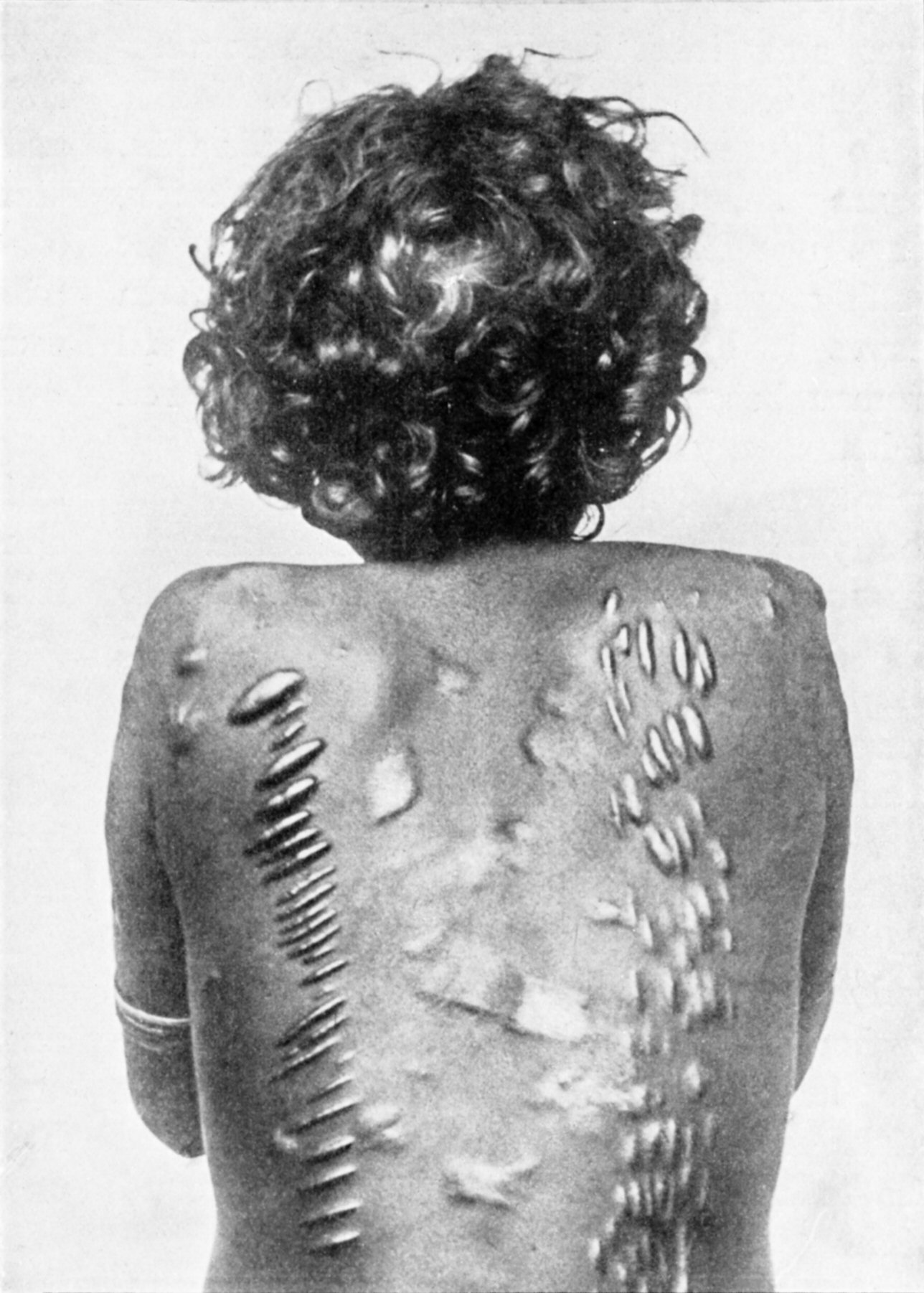 |
| Woman of the Larrakia tribe.The scars on her back are a sign of widowhood. |

Cooking snake, Northen Territory, Sydney Mail (NSW : 1912 - 1938), Wednesday 11 July 1917
 |
Eating the roasted snake, Northern Territory, Sydney Mail (NSW : 1912 - 1938), Wednesday 11 July
1917 |
In Honour of Charles Darwin
It was 69 years after the settlement of Australia by the British, that the first European person sighted Darwin. It was on 9 September 1839 that John Lort Stokes sailing on the HMS Beagle saw Darwin Harbour. The harbour was then named in honour of the famous English naturalist, Charles Darwin, who had sailed on the HMS Beagle on an earlier voyage.
The South Australian Government offered a £2,000 reward to the first person to successfully traverse the continent from Adelaide to the Arafura Sea. After several unsuccessful attempts, John McDouall Stuart, on his sixth expedition, reached Adam bay, east of Darwin in July 1862, and claimed the reward.
Various attempts were made to establish settlements before Darwin at
Port Essington,
Raffles Bay and
Fort Dundas. However, in 1869, George Goyder, the Surveyor-General of South Australia, established a successful British settlement at Port Darwin, with only 135 men and women. Though, initially, the settlement was called Palmerston, after the British Prime Minister, Lord Palmerston.
Goyder's survey camp became the nucleus of
the town. |
| Middle portion of the Government camp. The camp huts are raised from the ground and built of corrugated iron. Behind them stands a larger building constructed from wood palings. Cattle are grazing on the sparse vegetation on the hill behind the camp, Darwin, NT, 1860s, PD. |
 |
| Stereoscopic views illustrating the Northern Territory Survey Expedition, 1868-70, led by George W. Goyder, at the main camp, with Fort Hill on the left, Darwin, NT. Approximately 1869, SLSA |
 |
| Government surveying party, Palmerston campsite. The area was known as Fort Hill and was the location of George Goyder's survey camp. About 1869. Public Domain. |
 |
| Entrance to Darwin harbour and Goyder's Camp, Port Darwin. 1869-1870, State Library of Victoria |
The original 1870 Palmerston Police Station and cells were destroyed by white ants.
Various administrative departments were established from 1869, including a meteorological observatory, police inspector’s office, and medical office.
1870s
The Overland Telegraph
In 1871, the construction of the Overland Telegraph Line began: a 3200 km telegraph line that connected Darwin with
Port Augusta in South Australia. This cable also connected Australia with the rest of the world.
 |
| Palmerston Telegraph Offices (including the Post and Telegraph Office and the Cable Company offices) and the Superintendent's quarters. The three buildings looked sturdily built of stones and iron. About 1870s. Public Domain |
 |
| A group of men, women and children have assembled for the installation of the first pole of the Overland Telegraph on the 15th September, 1870s. Public Domain. |
 |
| The stables of the Goyder Survey Expedition party, Darwin, NT, Approximately 1870, SLSA |
 |
| Landing the telegraph cable at Port Darwin. A large group of men are holding the cable. The ship, 'Hibernia' is in the background, circa 1871. State Library of SA |
Following the Telegraph, a port was constructed, followed by a gold rush period in the 1870s.
Gold!
It was during the construction of the Overland Telegraph in 1875 that gold was discovered at Pine Creek, 226 km south-east of Darwin. This caused an influx of migrants from Europe and China into the region, many of whom
passed through Darwin.
 |
| Mr. Solomon's house, Darwin. The Hon. Vaiben Louis Solomon was the Premier of South Australia and represented the Northern Territory in the South Australian House of Assembly, circa 1870. State Library of SA |
 |
| Commercial Hotel, Palmerston (Now Darwin) Mitchell Street, NT, 26-Feb-1874. State Library of South Australia |
 |
| DARWIN, NT: The Telegraph and Cable Office. 1875, SLSA |
Shipwreck
There are many shipwrecks in Darwin Harbour including, schooners, pearling luggers, and ships sunk during WWII.
In February 1875, the steamship SS Gothenburg left Darwin for Adelaide with approximately 98 passengers and 37 crew (surviving records vary). There were government officials onboard, circuit court judges, the French Vice-Consul Eduard Durand, several prisoners and many Darwin residents. During the journey, the ship encountered severe weather conditions and was lashed by rain.On the evening of 24 February, the ship running at full speed hit a section of the Great Barrier Reef at low tide. Around midnight, the engine room flooded disabling the ship's engine, and waves began entering cabins. The severity of the storm made using the lifeboats impossible. Most records state a death toll of 102, with only 22
people surviving.
 |
| The SS Gothenburg left Darwin in February 1875. The wreck lies between 9 and approximately 16 metres (52 ft) of water on the western side of Old Reef, 130 kilometres (81 mi) southeast of Townsville. |
Building a Town
 |
| Various people are posing on the wide verandah of the saw mill residence which is a small weatherboard structure. Horse drawn vehicles are shown in the foreground, one of which is harnessed to a tandem team. The sheds of the saw mill are in the background. [On back of photograph] 'Manders' Saw Mill / Palmerston / 1878 / Mr. Manders' residence and steam saw mill, 1878 / Bennett Street / (Vide Foelsche album of views, lent by L.J. Burton, Kapunda)'. Darwin, NT, Approximately 1878, SLSA |
 |
In the foreground is the Government camp which is a mixed collection of buildings in various states of repair. Some are of corrugated iron, earlier ones of timber. The Government residence on the hill on the left has a flagstaff and appears to be having building work done. There are other well built houses or public buildings in the distance. Circa 1878. P.D.
|
 |
Chinaman's garden, hospital and Peel's Well, Palmerston (Darwin), Doctor's Gully 1878. State Library of South Australia.
|

Mitchell Street, Palmerston, NT, showing a smart new house on one corner. This is constructed from timber with an iron roof. There is a wrap around verandah to keep out the sun. Darwin, 1879, SLSA
1880s
 |
| Old Jetty, Darwin, NT, about 1880. NLAUST |
In 1881 stone police cells at the rear of the original site were erected.
 |
| The Camp, with H. M. S. Myrmidon at anchor in the port. This Cormorant-class gunvessel of the Royal Navy was built at Chatham Dockyard and launched in 1867. She was used for surveying the Australian coast. Darwin, NT, 1885, SLSA |
Brown’s Mart was built in 1885 as a Mining Exchange by Mr Brown who was a trader and a Mayor of Darwin.
 |
| Brown's Mart, built in 1885, Darwin, NT |
Northern Territory's first politician was Vaiben Louis Solomon. Vaiben Solomon was born into an Orthodox Jewish family in
Adelaide, South Australia. His shop which was named Solomon’s Mart was reported on by the
Northern Territory Times, during
its construction, in early January 1885:
We understand that Messrs V.L. Solomon and Co have arranged to build a large stone warehouse on the allotment adjoining Mr Bull’s store in Smith Street, immediately opposite the Town Hall. It is to be hoped that this example will be followed by others and permanent stone buildings soon replace most of the somewhat frail structures of wood and iron which have hitherto satisficed [sic] the ambitions of our local builders.
In 1889 a rail line was
completed between Port Darwin and Pine Creek. Chinese labourers had been recruited from China, and by 1888, the Chinese population of the Northern Territory was at 6000. On the goldfields, the Chinese outnumbered the Europeans by 16 to 1 (
see here).
A railway was built to Pine Creek in 1889.
1890s
 |
| A goods train at the 2 1/2 Mile Yards, Port Darwin, NT. SLSA |
 |
| Aboriginal men at Port Darwin, NT, circa 1890, SLSA |
 |
| Aboriginal men, women and children, Darwin, NT, during the 1890s |
 |
Chinese housing near Palmerston (Darwin), circa 1895
|
During the 1897 Cyclone about six ships were wrecked in Darwin harbour.
 |
| View of China Town from Joss-house [after cyclone damage, Darwin, Northern Territory, circa 1897]. National Library of Australia |
 |
| A family group at Darwin Wharf, NT, sitting in the shade of a railway wagon, Darwin, Northern Territory, circa. 1880s-1900.Wagait man "Nabbang" is seated third from right. Photographer unknown. |
 |
| Commercial Bank and the Victoria Hotel, Port Darwin, NT, 1895 |
1900sIn 1902 the Government established smelting works, at a place known as 2.5 Mile, just outside of Palmerston (Darwin).
From 1 January 1911, the Northern Territory became the responsibility of the Commonwealth Government, as South Australia's administration had a huge debt and mining a
nd agriculture had not been entirely successful.
 |
| Cocoanut Palms, Botanical Gardens, Port Darwin, Northern Territory - very early 1900s, Aussie~mobs |
 |
| The premises of the Commercial Bank of Australia and other buildings in Bennett Street, Darwin, Northern Territory. About 1900. P.D. |
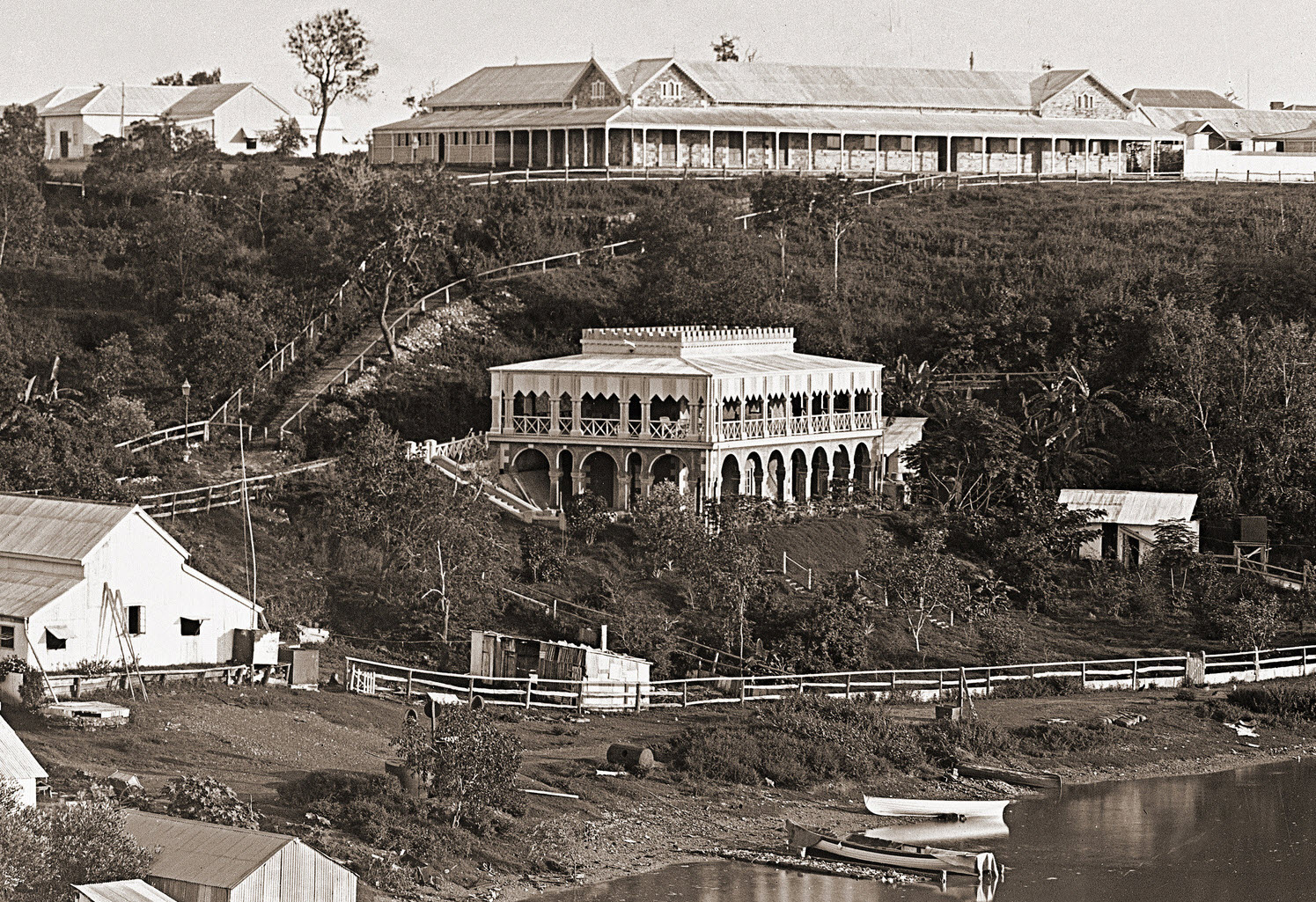 |
| Mud Hut also Known as Knight's Folly in Darwin taken in 1902 |
 |
Fashions in Darwin, Northern Territory - very early 1900s Kaye
|
 |
| Natives in Darwin, N.T. - very early 1900, Aussie~mobs |
 |
| Darwin, Northern Territory - very early 1900s, Aussie~mobs |
 |
| A Chinese man carting firewood in Darwin, Northern Territory - very early 1900s, Aussie~mobs |
 |
| Banyan Tree, Cavanagh Street, Darwin, Northern Territory - early 1900s, Aussie~mobs |
 |
| Palmerston (Darwin) and Pine Creek railway, NT, Observer (Adelaide, SA : 1905 - 1931), Saturday 19 August 1905 |
 |
| HIS EXCELLENCY THE GOVERNOR GENERAL (LORD NORTHCOTE) RECEIVING AN ADDRESS FROM THE DISTRICT COUNCIL OF PALMERSTON. Observer (Adelaide, SA : 1905 - 1931), Saturday 29 June 1907 |
 |
| Branding cattle in Port Darwin, N.T. - very early 1900s, Aussie~mobs |
 |
| Hotel Victoria, Darwin, Northern Territory, Australia - circa 1910. Kaye |
From 1911 to 1919 was a period of political and trade union unrest.
 |
| Fisherman at Port Darwin, NT, Sydney Mail and New South Wales Advertiser (NSW : 1871 - 1912), Wednesday 22 November 1911 |
 |
Maid servant Cissie McLeod stands by Mrs Mugg (B. James) seated in cane chair outside Government House in Darwin in the Northern Territory of Australia. McLeod was born in Borroloola, the daughter of Polly and Arthur McLeod. She had one sister, Clara. McLeod was adopted by Captain Frederick Mugg, of the Government Steamer in Darwin, and his wife Mrs Mary Mugg. She attended the Convent school in Darwin. Cissie McLeod was awarded a bronze medal for bravery on 12 September 1913
|
 |
| Chinatown in Darwin, Northern Territory c 1914, SLSA |
WWIThe Darwin Cable Guard was the first defence force in northern Australia after the Northern Territory came under control of the Commonwealth in 1911.
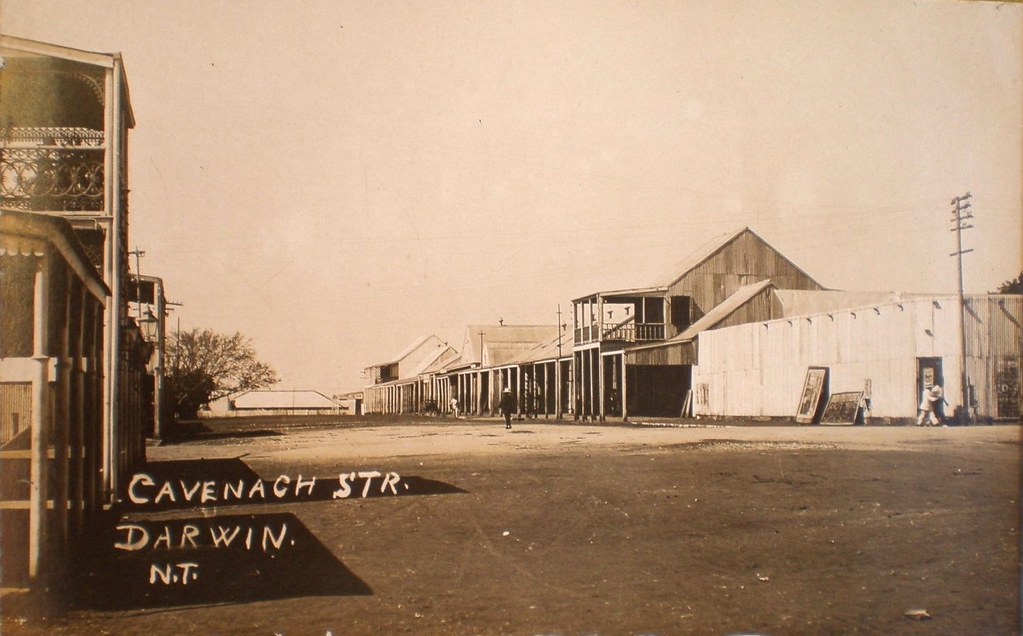
Cavenagh Street, Darwin, N.T. showing outdoor picture theatre on the right - 1915.
Aussie Mobs.
 |
| The Administrator of the Northern Territory, Government House , Darwin, NT, Western Mail (Perth, WA : 1885 - 1954), Friday 23 February 1917 |
 |
| The Darwin Cable Guard was the first defence force in northern Australia after the Northern Territory came under control of the Commonwealth in 1911. Sydney Mail (NSW : 1912 - 1938), Wednesday 14 March 1917 |
 |
| Alfred Richard Bradshaw, Enlistment Place: Darwin, Northern Territory, Northern Herald (Cairns, Qld. : 1913 - 1939), Friday 14 December 1917 |
 |
| William Allen from Darwin and served in the 11th Light Horse Regiment in WW1, Northern Herald (Cairns, Qld. : 1913 - 1939), Thursday 31 January 1918 |
The Darwin Rebellion
The Darwin Rebellion of 17 December 1918, was the nearest thing to a revolution in Australia since the Eureka Stockade at Ballarat in 1854.
On this day, the Australian Workers' Union led by Harold Nelson and up to 1000 demonstrators
marched on Government House at Liberty Square in Darwin where they burnt an effigy of the Administrator of the Northern Territory, John Gilruth, and demanded his resignation, demanding no taxation without representation.
 |
| Photo taken on 17 December 1918 showing demonstrators marching through the city of Darwin towards Government House. Northern Territory Archives |
Flight
On 12 November 1919, Ross and Keith Smith, with mechanics Wally Shier and Jim Bennett, left Hounslow, near London, flying to Australia in a Vickers Vimy. They arrived 28 days later in Darwin, NT, and claimed the £10,000 prize offered by the Commonwealth Government for the first Australians to fly from England
to Australia in less than 30 days.
 |
| Wrigley and Murphy's plane - first pilots to fly from Melbourne to Darwin - 1919, Aussie~mobs |
 |
| The first Australians to fly from England to Australia in less than 30 days, Western Mail (Perth, WA : 1885 - 1954) |
 |
| Sunday Times (Perth, WA : 1902 - 1954), Sunday 10 August 1919, |
 |
| "Native women mustering cattle", Port Dawin, NT, Weekly Times (Melbourne, Vic. : 1869 - 1954), Saturday 5 July 1919 |
 |
| Aboriginal gathering, Darwin, NT, Sydney Mail (NSW : 1912 - 1938), Wednesday 29 January 1919 |
Many of the early stone buildings which still remain in Darwin are attributed to the architect John George Knight (c.1824–1892).
1920s
When Commonwealth took responsibility for the Northern Territory in 1911,
the state lost its political representation. However, in 1922, the Territory had a representative in the House of Representatives.
 |
| Government offices on the Esplanade, Darwin, N.T. - circa 1920s, Aussie~mobs |
 |
| VESTEY'S MEAT WORKS. PORT DARWIN. RECENTLY CLOSED DOWN, Capricornian (Rockhampton, Qld. : 1875 - 1929), Saturday 30 October 1920 |
 |
| Views of Darwin, NT, Western Mail (Perth, WA : 1885 - 1954), Thursday 26 May 1921 |
1930s |
| Darwin Gaol operated as Her Majesty's Gaol and Labour Prison, from 20 September 1883 until 1 September 1979. Sun (Sydney, NSW : 1910 - 1954), Friday 21 April 1933 |
 |
| Chinese procession in Darwin, NT, Chronicle (Adelaide, SA : 1895 - 1954), Thursday 16 March 1933 |
 |
| Qantas aircraft, Hippomenes, arriving at Darwin with second experimental airmail, pilot, Hudson Fysh, 19 May 1931. Out of copyright. Qantas began in Winton, Queensland, in 1920. But in 1943, QANTAS and Britain's Imperial Airways formed a new company called Qantas Empire Airways Limited (QEA) and began flights between Brisbane and Darwin. In 1935, the air service from Darwin was extended to Singapore. |
 |
| Studying the bills outside Darwin picture theatre, Nt, Chronicle (Adelaide, SA : 1895 - 1954), Thursday 5 September 1935 |
 |
| A native burial corroboree in progres near Darwin, NT, Chronicle (Adelaide, SA : 1895 - 1954), Thursday 5 September 1935 |
 |
| "Magnificent Types of North Australian Natives" Sydney Mail (NSW : 1912 - 1938), Wednesday 20 September 1933 |
 |
| PREMIERSHIP OF NORTH AUSTRALIA. These photographs from Darwin, where the football season has just finished, show the premiers, Waratah, on the left, and the Buffalo team, runners up, on the right. Chronicle (Adelaide, SA : 1895 - 1954), Thursday 25 May 1933 |
 |
| IT is almost 19 years since the first aeroplane from overseas reached Darwin.West Australian (Perth, WA : 1879 - 1954), Thursday 24 November 1938 |
 |
| Darwin Mobile Force were admired by the large crowd in King George's Square during the inspection by the Lord Mayor (Alderman Jones), Sunday Mail (Brisbane, Qld. : 1926 - 1954), Sunday 19 March 1939 |
 |
| During the depression swagmen began camping at Frog Hollow and it became a shanty-town, Darwin, NT, Daily News (Perth, WA : 1882 - 1950), Saturday 8 July 1939 |
 |
| Courier-Mail (Brisbane, Qld. : 1933 - 1954), Saturday 14 October 1939 |
 |
| In 1939, the Reverend Leonard Kentish was transferred to Goulburn Island mission as District Chairman, where he began translating the New Testament into Maung (Aboriginal language). In 1943, Reverend Kentish was on HMAS Patricia Cam when the ship was bombed by a Japanese floatplane, sinking it almost immediately. A second bomb was dropped and the survivors were machine gunned for 30 minutes. The floatplane landed and captured Rev. Kentish at gunpoint. He was staved and beaten and then, beheaded by the Japanese. Those who survived were rescued and taken to Darwin. Northern Miner (Charters Towers, Qld. : 1874 - 1954), Saturday 18 May 1946 |
1940s and WWII
The construction of the Stuart Highway in 1941.
 |
| News (Adelaide, SA : 1923 - 1954), Saturday 13 December 1941 |
 |
| Shark catch Darwin Harbour, NT, Australasian (Melbourne, Vic. : 1864 - 1946), Saturday 8 February 1941 |
 |
| Headquarters of a wealthy Chinese merchant in Chinatown, Darwin, MT, Newcastle Morning Herald and Miners' Advocate (NSW : 1876 - 1954), Friday 20 February 1942 |
 |
| Darwin, NT, Daily Telegraph (Sydney, NSW : 1931 - 1954), Friday 20 February 1942 |
Darwin Bombed!
On 19 February 1942, during World War II, Darwin was bombed by Japanese fighter planes and bombers.
The 260 enemy aircraft attacked the port and shipping twice during the same day, killing 252 Allied service personnel and civilians. In April, June, July and November of that year, Darwin was attacked again by Japanese aircraft, mostly during the day. Many other northern Australian towns were also bombed during 1942.
 |
| Mercury (Hobart, Tas. : 1860 - 1954), Friday 20 February 1942 |
 |
| Australian Army bomb disposal experts recovering an unexploded Japanese aerial bomb, Darwin, NT, February 1942. Australian War Memorial |
 |
| Damage to Darwin Post Office and surrounding buildings, Darwin, NT, circa: 19 Feb, 1942. Australian War Memorial |
 |
| Oil tanks on Stokes Hill burning during the first Japanese air raid, Darwin, NT, Feb 1942 |
 |
| Gordon's Don Hotel in Darwin, N.T. damaged by a Japanese air raid in 1942. Kaye |
 |
February 19, 1 942, Japanese planes dropped bombs on the town in the first air raid on the
mainland of Australia, Darwin, NT, Brisbane Telegraph (Qld. : 1948 - 1954) |
 |
| Unidentified nurses on board the HMAHS Manunda. The vessel was damaged on 19 February 1942 when the Japanese bombed Darwin. Australian War Memorial |
On the morning of 19 February 1942, the vessel
Manunda was bombed during Japanese air raids on Darwin, even though the ship displayed highly
prominent red cross markings. 12 members of the ship's crew and hospital staff were killed, 19 others were seriously wounded, and another 40 or so received minor wounds.
 |
| Corporal (Cpl) Dolly, the No. 1 member of the Aboriginal Women's Hygiene Squad at the 69th Australian Women's Army Service (AWAS) Barracks. Cpl Dolly was in Darwin during the first bombing. Australian War Memorial |
.jpg) |
A camera gun photograph taken from a Spitfire flown by Flight Sergeant Batchelor of No. 457 Squadron RAAF, during the 58th Japanese air raid on Darwin. The aircraft in the camera gun frame is a Japanese Mitsubishi G4M1 Betty. Darwin, NT. 6 June 1943.
|
 |
| Examiner (Launceston, Tas. : 1900 - 1954), Monday 1 February 1943 |
 |
| Western Mail (Perth, WA : 1885 - 1954), Thursday 23 August 1945 |
 |
| Christ Church, Darwin, NT, circa 1949 |
 |
Retail store and Post Office in Darwin, N.T. - 1940s, Aussie~mobs
|
1950s
 |
| West Australian (Perth, WA : 1879 - 1954), Friday 12 June 1953 |
 |
| "Photograph 0066 - Darwin's E S and A Bank 1959" by kenhodge13 is licensed under CC BY 2.0 |
 |
| The Hotel Darwin, NT, public bar on the left, bottleshop in the centre and Hot and Cold Bar on the right. The Hot and Cold was the one airconditioned bar in Darwin and the most popular venue with 5ACS members. Like the majority of licensed premises in 1959 the Hotel Darwin was a Swan Brewery outlet. Photographer: Ken Hodge |
1970s
 |
| The Victoria Hotel in Smith Street Darwin, NT, in August 1972. This photograph is a frame from a super 8 film taken in August 1972. Ken Hodge |
 |
| Cavenagh Street central parking in August 1972, Darwin, NT. The central parking was removed in the 1980s and replaced by a lacklustre median strip. This photograph is a frame from a super 8 film taken in August 1972. Ken Hodge |
 |
| The intersection of Goyder Road and the Stuart Highway in August 1972. Photographer: Ken Hodge |
Cyclone Tracy
Early on Christmas Day in 1974, Cyclone Tracy devastated the city of Darwin, killing 71 people and causing millions of dollars in damage. Before the Bureau of Meteorology's anemometer broke, the cyclonic winds were recorded as moving at a speed of 217 kilometres per hour. Buildings were razed, glass shattered, and power, water supply, sewerage and telephone lines were terminated. 66 people died.
In February of 1975, Prime Minister Gough Whitlam established the Darwin Reconstruction Commission, which was given the task of rebuilding the city "within five years". However, many of those people who had endured the horror of Cyclone Tracy left Darwin, and the city that was rebuilt from the ruins had little resemblance to the old pre-Tracy Darwin.
 |
Damaged houses after the passage of Cyclone Tracy on Christmas day 1974 in Darwin, Australia |
 |
| The Victoria Hotel after Cyclone, circa 1974 |
Despite the devastation from various cyclones, there are still various sites of historical importance to explore in Darwin today. There is the evidence of Darwin's World War II history, Fannie Bay Gaol and various other historical buildings, as well as the Dariba Nunggalinya (Old Man Rock), which can be seen at low tide from Dripstone Cliffs lookout, which has significance for the local Larrakia people.
 |
| RAV RV4 arrives to go on display for the official opening of the new Darwin Airport Terminal. 1991, Ken Hodge |
 |
| Vickers Vimy 75th Anniversary of London to Darwin Flight. A Vickers Vimy replica piloted by Australian Lang Kidby and American Peter Mcmillan was flown from England to Australia to commemorate the original epic journey of 1919. The Vimy touched down in Darwin on 22nd October 1994 after a trip of approximately six weeks. A large crowd of locals came to inspect the Vimy during its stay at RAAF Darwin. Ken Hodge |
2000s
Around Darwin
 |
| Darwin Town Hall, opened in 1883, destroyed by Cyclone Tracy in 1974 |
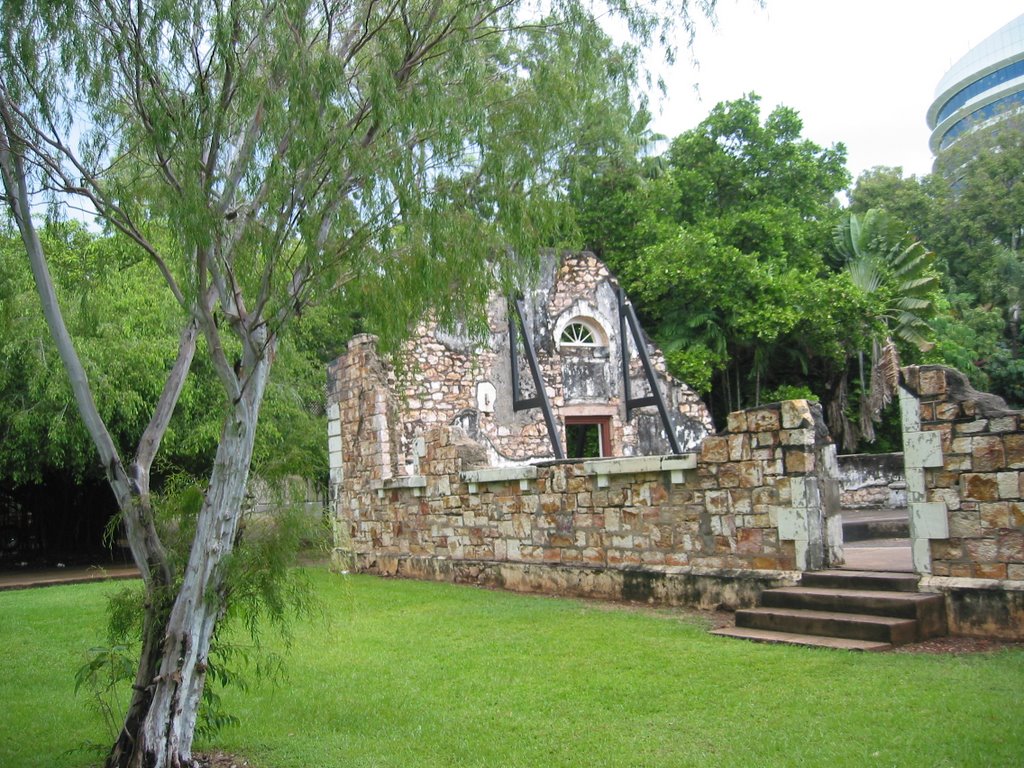 |
| Ruins of Darwin Town Hall, Darwin, NT |
 |
| Government House is the office and official residence of the Administrator of the Northern Territory. Built between 1870 and 1871, with later renovations between 1878 and 1879. |
 |
| Darwin Aviation Museum |
 |
| The ruinsof the Old Darwin (Palmerston) Town Hall in Smith Street. The building which was completed in 1883, was severely damaged by Cyclone Tracy in 1974 that it was not rebuilt. |
 |
| Opened in September 1883, Fannie Bay Gaol was Darwin's main prison for almost 100 years until 1979. |
 |
| Lyons Cottage, on the corner of The Esplanade and Knuckey Street. Colonial-style stone house built in 1925 for engineers working on the Australia–UK telegraph cable. |
.jpg) |
| Burnett House at Myilly Point in the Darwin suburb Larrakeyah. It is believed that Myilly Point was first subdivided into house lots in about 1915. |
 |
| Wagait beach Darwin WW2 plane wreck (B24-J Liberator). |
 |
| East Point Military Museum. Darwin, NT |
 |
| The old stone courthouse erected in 1884 |
 |
| Significant Aboriginal sites include Darriba Nungalinya. (Old Man Rock), visable at low tide from Dripstone Cliffs lookout. |
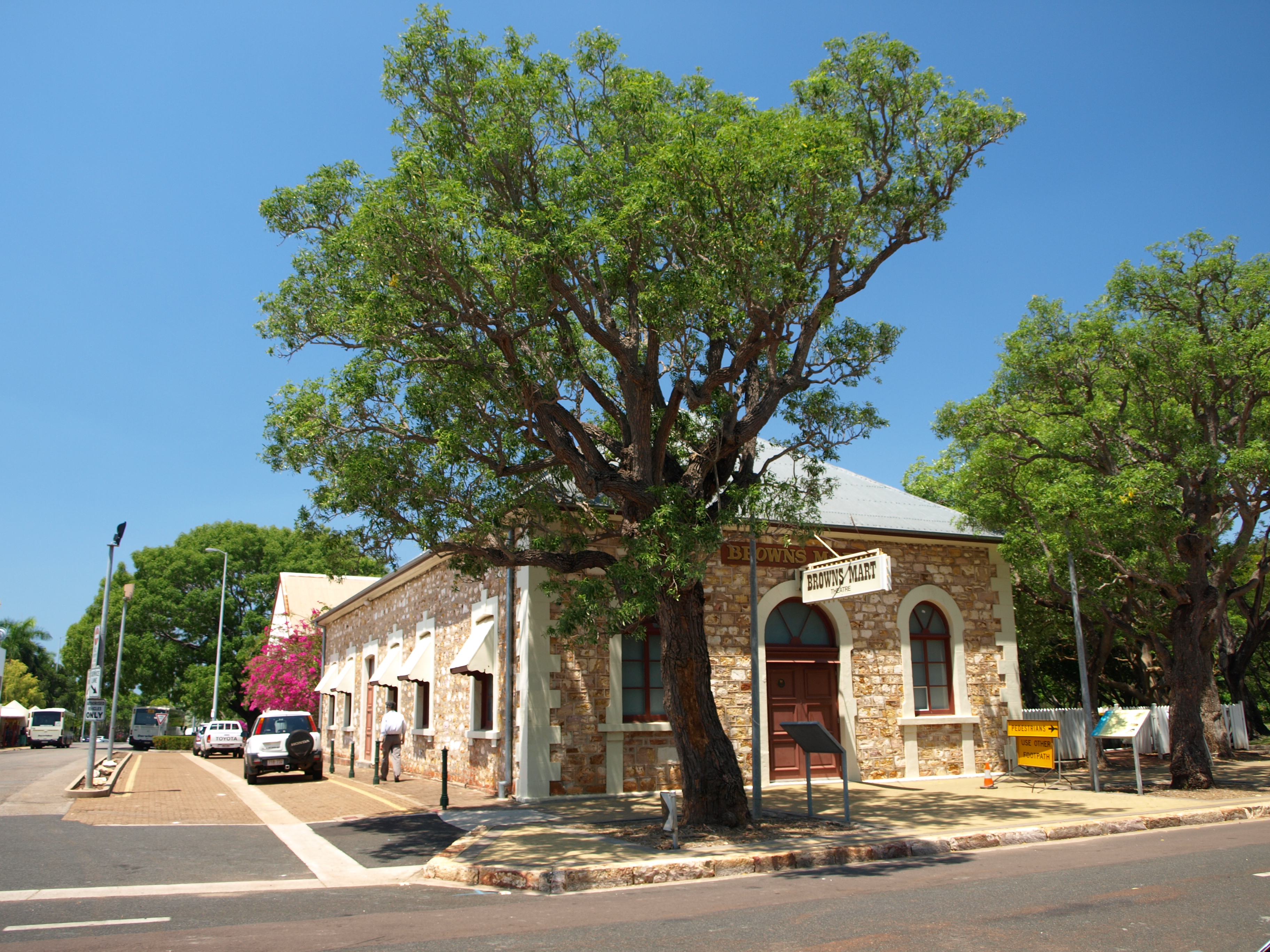 |
| Browns Mart was an Administrators building, designed by JG Knight and constructed in 1885 for VL Solomon and became known as Solomon's Emporium. |
 |
| Cyclone Tracy ruins of the original Christ Church (1902), Darwin, NT |
Things To Go and Places To Go






















































































.jpg)





























.jpg)


